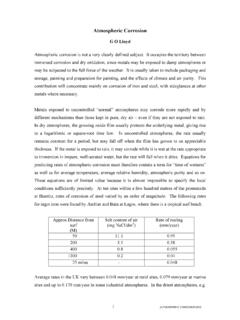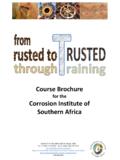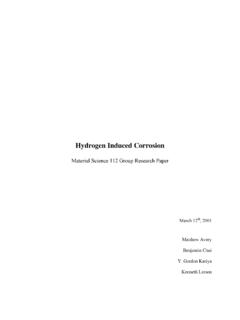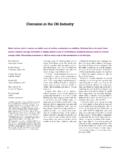Transcription of Reliable corrosion inhibition in the oil and gas …
1 Health and Safety Executive Reliable corrosion inhibition in the oil and gas industry Prepared by the Health and Safety Laboratory for the Health and Safety Executive 2014. RR1023. Research Report Health and Safety Executive Reliable corrosion inhibition in the oil and gas industry James Hobbs MEng PhD. Health and Safety Laboratory Harpur Hill Buxton Derbyshire SK17 9JN. The objective of the work was to undertake a literature review on the subject of corrosion inhibition in the offshore oil and gas industry to understand the current issues. The application of chemical corrosion inhibitors can significantly reduce the rate of corrosion of carbon steel pipelines due to the presence of CO2 and/or H2S.
2 An inhibited corrosion rate of mm/year can typically be achieved, which is largely independent of the uninhibited corrosion rate. The report covers the main factors affecting the effectiveness of chemical corrosion inhibitors; they are not effective against corrosion due to the presence of oxygen or microbacterial corrosion . High flow rates, high temperature, solids (either dissolved or suspended) and pre-existing corrosion can all have a negative effect on corrosion inhibitor effectiveness. The role of Key Performance Indicators (KPIs), the main factors affecting the performance of inhibition injection systems, and the levels of inhibitor availability that can be assumed at the design stage and achieved in practice are also discussed.
3 This report and the work it describes were funded by the Health and Safety Executive (HSE). Its contents, including any opinions and/or conclusions expressed, are those of the authors alone and do not necessarily reflect HSE policy. HSE Books Crown copyright 2014. First published 2014. You may reuse this information (not including logos) free of charge in any format or medium, under the terms of the Open Government Licence. To view the licence visit , write to the Information Policy Team, The National Archives, Kew, London TW9 4DU, or email Some images and illustrations may not be owned by the Crown so cannot be reproduced without permission of the copyright owner.
4 Enquiries should be sent to ii CONTENTS. 1 INTRODUCTION .. 1 2 corrosion inhibition .. 2 3 FACTORS EFFECTING corrosion RATES AND INHIBITOR. EFFICIENCY .. 3 4 Flow 4 Temperature .. 5 corrosion Models .. 6 Inhibitor Effectiveness .. 7 4 9 Injection System Monitoring .. 9 corrosion Monitoring .. 9 Condition Monitoring .. 10 5 KEY PERFORMANCE INDICATORS .. 12 Inhibitor Availability Measures .. 12 corrosion Inhibitor Availability Requirements from Design .. 15 6 ASSESSMENT OF FAILURES .. 24 7 CONCLUSIONS .. 26 8 REFERENCES .. 27 iii EXECUTIVE SUMMARY. Objectives To undertake a literature review on the subject of corrosion inhibition in the oil and gas industry to understand the current issues.
5 Main Findings The application of chemical corrosion inhibitors can significantly reduce the rate of corrosion of carbon steel pipelines due to the presence of CO2 and/or H2S. An inhibited corrosion rate of mm/year can typically be achieved, which is largely independent of the uninhibited corrosion rate;. Various factors can affect the effectiveness of chemical corrosion inhibitors; they are not effective against corrosion due to the presence of oxygen or microbacterial corrosion . High flow rates, high temperature, solids (either dissolved or suspended) and pre-existing corrosion can all have a negative effect on corrosion inhibitor effectiveness.
6 The main Key Performance Indicator (KPI) used for assessing effectiveness of corrosion inhibitors is based on the proportion of time that the correct dosage of inhibitor is applied (termed inhibitor availability);. Maintaining a high level of availability can be difficult in the long term, due to a number of factors, the main factors being failure of the diaphragm in the pump and failure of the pressure control valves;. The maximum availability that can safely be assumed for design calculations has been a matter of debate: o The NORSOK M-001 standard specifies that inhibitor availabilities above 95%. should not be used in a design assessment;. o BP Amoco have also used an upper limit of 95% availability.
7 O Shell have allowed an availability of 99% to be assumed;. o A recent paper by BP Exploration has stated that designs based on 99%. availability are becoming increasingly common, and demonstrated a pilot skid that achieved availability, albeit with an assessment time of just a few months. A review of inhibition availability by Ionik Consulting found that systems with target availability of over 95% were unable to achieve this level of availability, with actual availability between 85% and 95%. iv 1 INTRODUCTION. Pipelines are required to transport oil and gas products from the well, sometimes over long distances. In addition to oil and/or gas, it is common that wells produce other products that are likely to cause corrosion , such as water and carbon dioxide.
8 As the pipelines often have design lives in the order of decades, steps need to be taken to ensure integrity over the life of the plant and therefore, steps need to be taken to manage the levels of corrosion . During the design stage, decisions need to be taken on how corrosion is to be managed. There are two main options where a corrosive environment is present; 1) use corrosion resistant alloys (CRA) or 2) use cheaper carbon steel and employ corrosion reduction techniques. There is often a conflict between the capital cost (CAPEX) and the operational cost (OPEX) of plant, with CRAs being more expensive in terms of capital expenditure, but having a lower operational cost.
9 Chemical corrosion inhibitors can be very effective in reducing corrosion rates, with the potential to reduce corrosion rates by 99% or more given a suitable concentration of an appropriate inhibitor. Inhibitors work by forming a film on the surface of the steel, preventing corrosive attack. With corrosion rates being so much lower in the presence of corrosion inhibitor, the key in determining the overall rate of corrosion over the life of a pipeline becomes the proportion of time for which the corrosion inhibitor is available at the correct concentration. With pressure to reduce the capital expenditure and employ carbon steel instead of corrosion resistant alloys, designers are specifying higher corrosion inhibitor availabilities to enable acceptable lifetime corrosion rates to be achieved, especially in highly corrosive environments.
10 With higher specified corrosion inhibitor availabilities comes the requirement for more Reliable corrosion inhibitor injection systems. These require sophisticated monitoring systems, Reliable logistics in often remote locations, suitable backup systems and a commitment on behalf of the operator to make corrosion inhibition a priority. Another driver for high levels of corrosion inhibition is life extension of ageing plant. This can involve the added complication of lower corrosion inhibitor efficiencies where corrosion is already present. Pipeline failures due to corrosion could be very costly in terms of safety, environmental damage and cost. Therefore, effective corrosion inhibition is of high importance to the industry and a lot of research has been carried out on the factors affecting inhibitor effectiveness.

















